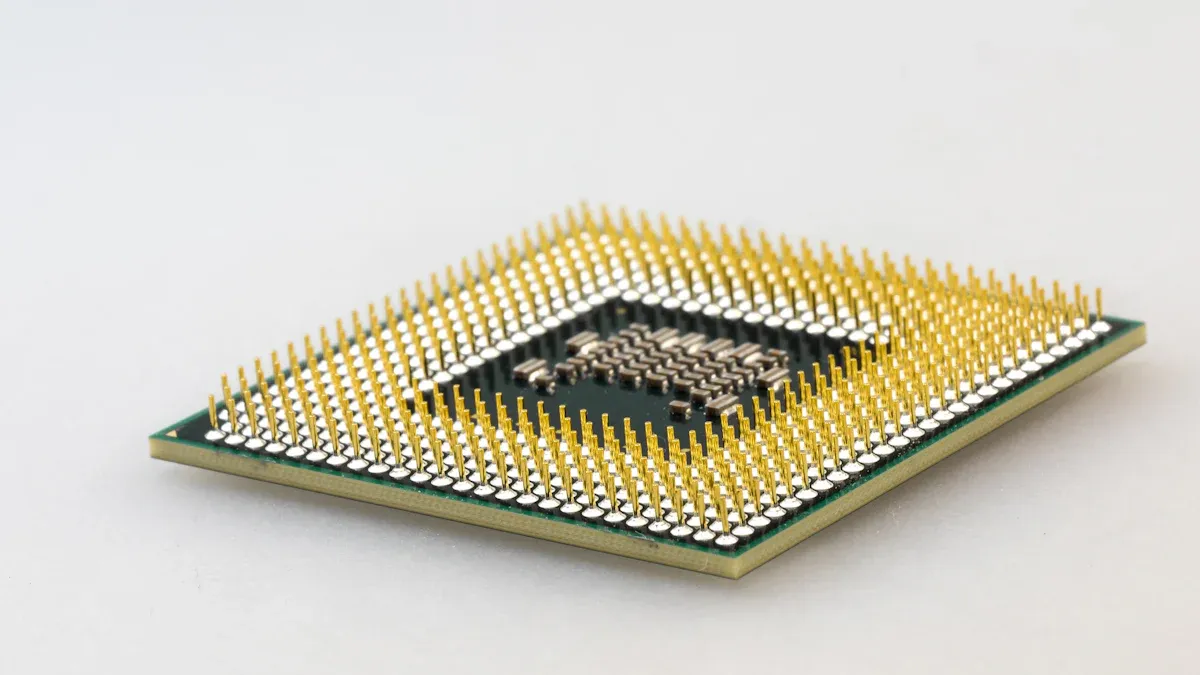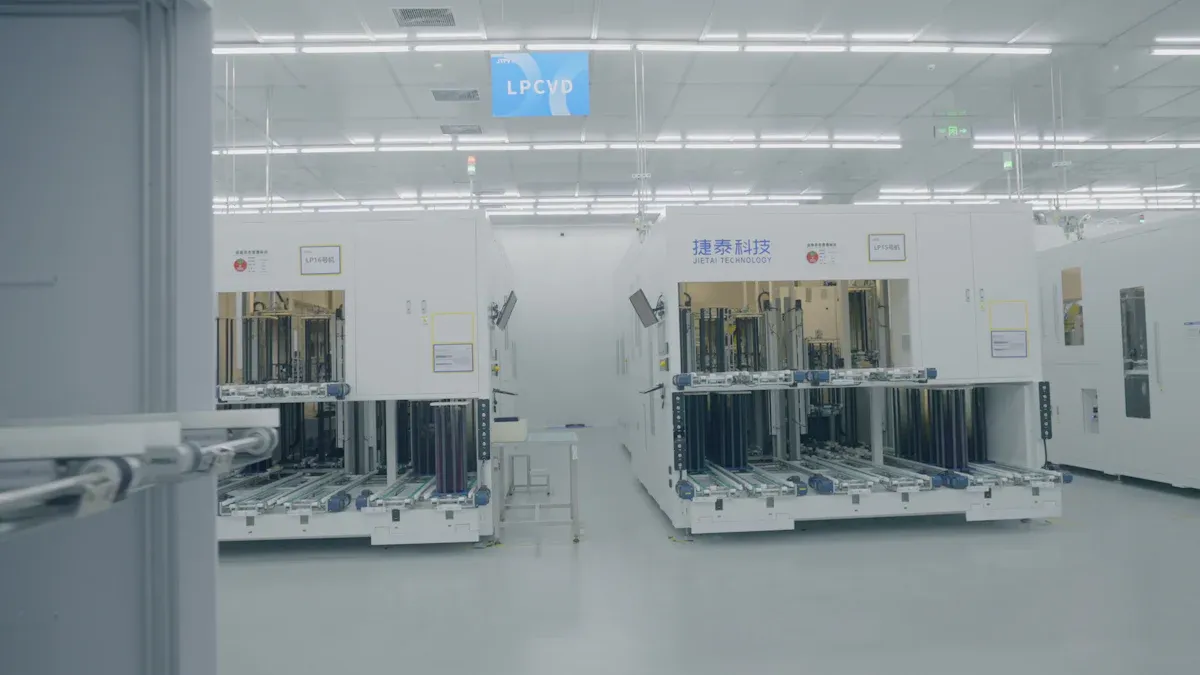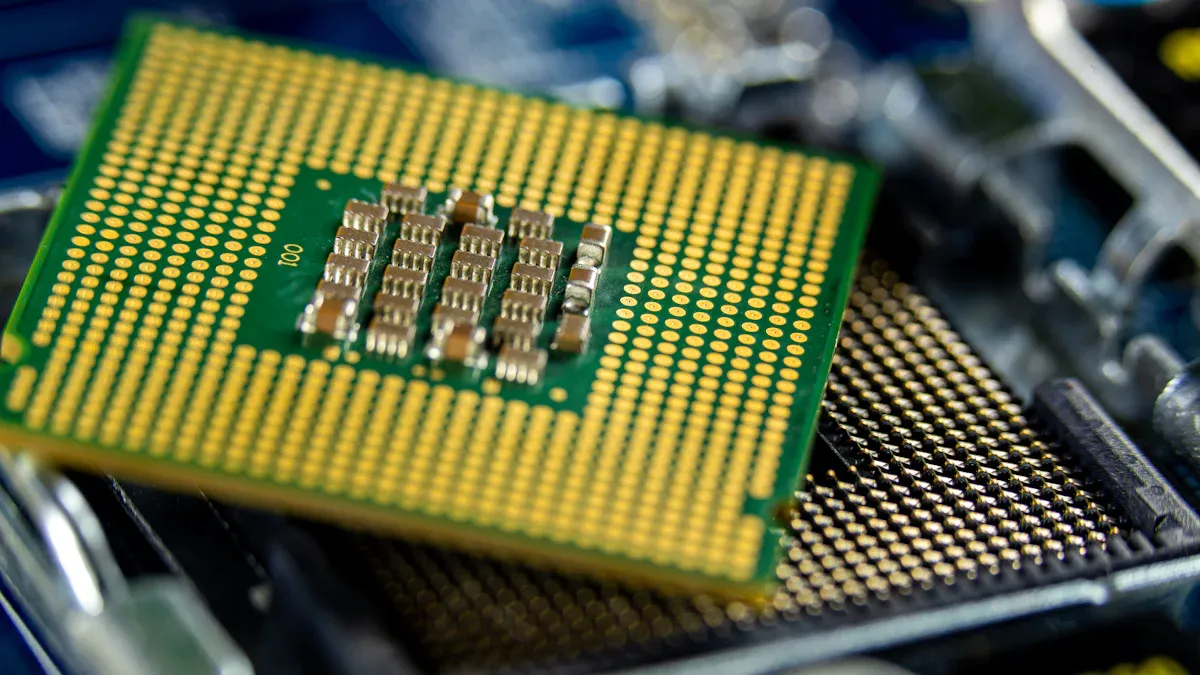Top 10 IC Chip Suppliers Leading the Market in 2025

The top 10 IC chip suppliers leading the market in 2025 include NVIDIA, TSMC, Samsung Electronics, Intel, Broadcom, Qualcomm, Micron Technology, ASML, AMD, and SK Hynix. These companies drive technology and innovation in a market projected to reach $697 billion in 2025, according to Deloitte. IC chips power devices, data centers, and vehicles, making each ic chip supplier essential for global progress. Each company brings unique strengths and advancements that shape the future of electronics.
Key Takeaways
The global IC chip market is growing fast, expected to reach $697 billion in 2025 with strong demand from AI, data centers, and electric vehicles.
Top suppliers like NVIDIA, TSMC, Samsung, and Intel lead with advanced technologies in AI chips, manufacturing, memory, and processors.
Innovations such as energy-efficient designs, new chip packaging, and cutting-edge manufacturing nodes drive better performance and sustainability.
Each supplier focuses on different strengths, from AI GPUs and advanced fabrication to memory solutions and wireless connectivity.
Choosing the right IC chip supplier depends on technology leadership, supply chain stability, and innovation to support future growth and project success.
Market Overview

Industry Growth
The global semiconductor industry is set for strong expansion in 2025. Experts forecast semiconductor sales to reach $697 billion, up from $627 billion in 2024. This marks an impressive year-over-year growth rate of about 11.1%. The industry expects a compound annual growth rate (CAGR) of 7.5% through 2030. Silicon wafer shipments will also see a 10% increase in 2025, reflecting the rising demand for advanced chips.
Metric | Value | Year(s) |
|---|---|---|
Semiconductor sales (forecast) | $697 billion | 2025 |
Semiconductor sales (actual) | $627 billion | 2024 |
Year-over-year growth rate | ~11.1% | 2024 to 2025 |
Compound Annual Growth Rate | 7.5% CAGR | Up to 2030 |
Silicon wafer shipment growth | ~10% increase | 2025 |
Artificial intelligence and data centers play a major role in this growth. AI workloads in data centers require powerful chips and consume significant energy. As a result, manufacturers focus on designing energy-efficient chips and advanced packaging to meet these needs. The expansion of electric vehicles, smart devices, and 5G networks also drives demand for high-performance ICs. Each ic chip supplier invests in new technologies to keep up with these trends.
Key Trends
Several trends shape the IC chip industry in 2025:
Strong demand for AI and advanced technologies pushes the market forward.
Capital expenditures near $185 billion aim to expand manufacturing capacity by 7%.
Innovations in chip packaging, new materials, and AI-driven manufacturing improve efficiency and performance.
The automotive sector grows rapidly, with electric and autonomous vehicles needing more advanced chips.
The market for EV semiconductor devices is expected to grow at a 30% CAGR from 2025 to 2030.
Geopolitical factors and reshoring efforts influence supply chain stability.
Companies focus on eco-friendly manufacturing and energy-efficient chip designs.
Strategic collaborations among governments, academia, and industry help secure supply chains.
Note: AI and data centers not only drive demand but also push chipmakers to innovate in energy efficiency and performance. This focus ensures that the industry can support the next generation of technology while managing environmental impact.
Top IC Chip Suppliers
NVIDIA
NVIDIA stands as the leading ic chip supplier in the AI sector for 2025. The company holds an 80% share of the enterprise AI chip market. NVIDIA introduced the GeForce RTX 50 Series GPUs, built on the Blackwell architecture, which feature 92 billion transistors and deliver over 3,300 trillion AI operations per second. These GPUs bring advanced AI capabilities to both enterprise and consumer markets. NVIDIA also launched Project DIGITS, a personal AI supercomputer that allows local AI processing without relying on the cloud. This innovation improves privacy and reduces latency. The GB10 AI superchip, which combines the Blackwell GPU and Grace CPU, targets AI applications and humanoid robots. NVIDIA continues to expand its influence in gaming, robotics, automotive, and healthcare by investing $1 billion in AI startups and developing new AI-powered tools for game developers. The company’s focus on energy efficiency and AI-driven solutions keeps it at the forefront of the industry.
TSMC
TSMC remains the world’s largest semiconductor foundry and a critical ic chip supplier in 2025. The company commands over 56% of the global foundry market. TSMC leads in advanced manufacturing nodes, including 3nm and 5nm technologies, and began mass production of 2nm chips in the second half of 2025. The company’s CoWoS advanced packaging technology supports high-performance AI accelerators and high-performance computing (HPC) chips. TSMC’s U.S. investment totals $165 billion, with new facilities focusing on 2nm and 3nm nodes. The company’s revenue grew by 38.6% year-over-year in Q1 2025, driven by strong demand for AI chips from clients like Apple, NVIDIA, and AMD. TSMC’s ongoing expansion in Taiwan, the U.S., and Japan ensures a stable supply chain and supports the global growth of advanced electronics.
Aspect | Details |
|---|---|
Global Foundry Market Share | Over 56% in 2025 |
Advanced Node Technologies | 3nm, 5nm, and 2nm mass production |
CoWoS Packaging Capacity | 65,000–75,000 wafers/month in 2025; scaling to 150,000 by 2028 |
U.S. Investment Commitment | $165 billion |
Revenue Growth (Q1 2025) | 38.6% YoY |
Key Clients | Apple, NVIDIA, AMD |
Samsung Electronics
Samsung Electronics continues to lead in both memory and logic chip innovation. The company produces advanced DRAM and NAND products, including third-generation 10nm-class DRAM and seventh-generation V-NAND with nearly 200 cell layers. Samsung’s Exynos 990 mobile processor, built on a 7nm EUV process, features a dual-core NPU for AI workloads. The company also develops 11nm-class DRAM and ninth-generation V-NAND, aiming for the highest density in the industry. Samsung’s PCIe Gen5 SSDs and LPDDR5X CAMM32 solutions target high-performance markets such as PCs, data centers, and AI servers. The company invests heavily in R&D and collaborates with partners to optimize memory solutions for hyperscale AI, 5G, and autonomous vehicles.
Intel
Intel remains a major ic chip supplier with a strong focus on processor innovation. In 2025, Intel launched the Core Ultra 200V series and other processor lines, delivering significant gains in performance, efficiency, and security. These processors support advanced AI features and are designed for business productivity, mobile computing, and edge AI applications. Intel’s partnership with Microsoft brings Copilot+ PCs to market, offering over 400 AI features and improved battery life. The company plans to release Arrow Lake Refresh processors in the second half of 2025, which will include upgraded Neural Processing Units for enhanced AI inference and edge computing. Intel’s ongoing innovation ensures its relevance in both consumer and enterprise markets.
Broadcom
Broadcom leads the networking and connectivity IC chip market in 2025. The company holds a dominant position in Ethernet PHY chips, with a 26.87% revenue share. Broadcom’s product portfolio includes high-performance Ethernet PHY chips that support multiple standards and offer energy efficiency. The company also leads in merchant Gigabit Ethernet switch ICs. In 2025, Broadcom released VMware Cloud Foundation 9, a unified private cloud suite that simplifies cloud operations and supports both virtual machines and containers. Broadcom is advancing its AI semiconductor products, planning to deploy over one million custom AI accelerators by 2027. The company expects its AI semiconductor segment to grow by about 60% annually through 2026, reflecting strong momentum in AI hardware.
Qualcomm
Qualcomm stands out as a leader in 5G and AI chip innovation. The company’s edge-based AI solutions improve speed, energy efficiency, and privacy. Qualcomm’s software stack supports compact AI models with 7 to 10 billion parameters, enabling seamless task offloading between devices, edge servers, and the cloud. The Hexagon NPU, a dedicated AI accelerator, delivers efficient matrix and tensor operations while minimizing battery drain. Qualcomm’s Oryon CPU and redesigned Adreno GPU offer significant performance and efficiency improvements. The company’s AI Engine supports large multimodal models and generative AI, while its connectivity solutions include AI-driven 5G and Wi-Fi 7 technologies. Qualcomm’s innovations have earned industry recognition, including the 2025 Edge AI and Vision Product of the Year Award.
Micron Technology
Micron Technology remains a top ic chip supplier in the memory market. In 2025, Micron introduced the 1-gamma (1γ) DRAM manufacturing process, which improves efficiency, speed, and energy consumption. The company also advanced LPDDR5X memory, delivering faster performance with lower power usage. These technologies support AI, automation, and intelligent systems. Micron invests in domestic production, with new DRAM manufacturing facilities in Idaho, New York, and Virginia. The company’s focus on innovation and efficiency strengthens its leadership in memory technology.
ASML
ASML is the world’s leading supplier of advanced lithography equipment. In 2025, the company introduced the EXE platform, featuring High NA EUV lithography with a numerical aperture of 0.55. This technology enables high-volume manufacturing of chips at the 2nm node and below. The EXE systems, such as TWINSCAN EXE:5000 and EXE:5200B, use a 13.5 nm EUV light source to achieve resolutions of about 8 nm. ASML’s machines are essential for producing advanced AI chips and supporting Moore’s Law. The company’s High NA EUV systems are adopted by major chipmakers like Intel, TSMC, and Samsung. ASML continues to expand its presence in the U.S. and develop future lithography technologies.
AMD
AMD holds a strong position in both the CPU and GPU markets. In 2025, AMD’s CPU market share reached 40.31%, while its GPU share stood at 8%. The company launched the Ryzen AI Max Series and Ryzen AI 300 Series mobile processors, offering leading CPU performance and advanced AI capabilities. AMD also introduced new desktop and laptop processors with 2nd Gen 3D V-Cache technology, enhancing gaming and content creation. The company’s Zen 5 Threadripper 9000 WX processors, expected at COMPUTEX 2025, offer up to 96 cores and support for 3D V-Cache. AMD’s innovations target both consumer and business segments, with a focus on AI, gaming, and high-performance computing.
SK Hynix
SK Hynix became the global leader in the memory chip market in 2025, surpassing Samsung Electronics. The company captured a 36% share of the global DRAM market and holds over 70% of the high-bandwidth memory (HBM) market. SK Hynix developed the 12-layer HBM4 chip, which offers a 60% speed increase over previous generations. The company’s new memory products include the 12-high HBM3E, SOCAMM, CMM-DDR5, and GDDR7, targeting AI servers, data centers, and graphics cards. SK Hynix’s focus on advanced AI memory solutions and rapid production ramp-up solidifies its position as a top ic chip supplier in 2025.
IC Chip Supplier Comparison

Technology Leadership
The top IC chip suppliers in 2025 each show unique strengths in technology. TSMC leads in advanced semiconductor fabrication, producing chips at 3nm and 2nm nodes. Samsung stands out with broad technology leadership, offering products for consumer electronics, robotics, and medical equipment. NVIDIA dominates high-performance GPUs and AI computing, while Intel focuses on processors for PCs, servers, and autonomous driving. ASML supplies the world’s most advanced lithography systems, which enable the production of cutting-edge chips. Companies like Qualcomm and Broadcom push wireless and networking technologies forward. The table below highlights each company’s technology focus and market role:
Company | Technology Leadership Focus | Market Role / Specialization |
|---|---|---|
TSMC | Advanced chip fabrication | Largest contract manufacturer |
Samsung | Broad tech leadership | Diversified product portfolio |
NVIDIA | High-performance GPUs, AI | GPU and AI leader |
Intel | Processors, memory, IoT | Diversified tech leadership |
Broadcom | Networking, connectivity | Infrastructure chips |
Qualcomm | Wireless, Snapdragon chips | Mobile wireless leader |
SK Hynix | DRAM, NAND memory | Memory chipmaker |
Micron | Memory, storage | Memory chipmaker |
ASML | Lithography systems | Chip production equipment |
Market Presence
Market presence varies among the leading suppliers. TSMC holds the largest share, with 12.73% of the global market, driven by demand for AI and high-performance computing. Broadcom follows with 9.93%, focusing on networking and custom ASICs. Qualcomm, AMD, and Intel each target different segments, such as mobile, data centers, and embedded processing. Samsung and SK Hynix lead in memory chips, while ASML’s equipment is essential for advanced chip manufacturing. Each ic chip supplier targets specific markets, which creates a diverse and competitive ecosystem.
Note: Companies like TSMC and Samsung invest billions in R&D each year, supporting breakthroughs in chip design and manufacturing. Their partnerships with universities and research institutions help them stay ahead in technology.
Innovation Highlights
Innovation drives the semiconductor industry forward. In 2025, suppliers introduced impactful advancements:
TSMC and Samsung improved chip packaging and process nodes, enabling smaller, faster, and more efficient chips.
NVIDIA launched AI-driven GPUs that power enterprise servers and next-generation applications.
ASML’s High NA EUV lithography systems allow chipmakers to produce chips at the 2nm node and below.
Qualcomm advanced edge AI and wireless technologies, supporting 5G and IoT growth.
Companies like Micron and SK Hynix developed high-bandwidth memory for AI servers and data centers.
Sustainable manufacturing and new cooling technologies, such as liquid cooling for chips, help reduce environmental impact.
These innovations support new applications in AI, automotive, and cloud computing, ensuring that each supplier remains competitive and relevant.
Summary Table
Selecting the right IC chip supplier can shape the success of any technology project. The table below offers a clear comparison of the top 10 suppliers in 2025. Each company brings unique strengths to the market. This summary helps readers quickly identify which supplier aligns best with their needs.
Tip: Use this table as a quick reference when evaluating suppliers for projects in AI, data centers, mobile devices, or automotive applications.
Supplier | Core Strengths | Market Focus | 2025 Innovations & Highlights |
|---|---|---|---|
NVIDIA | AI GPUs, Accelerators | AI, Data Centers | Blackwell GPUs, Project DIGITS, GB10 AI chip |
TSMC | Advanced Chip Fabrication | Foundry Services | 2nm mass production, CoWoS packaging |
Samsung | Memory, Logic Chips | Consumer, Enterprise | 200-layer V-NAND, Exynos 990, PCIe Gen5 SSD |
Intel | CPUs, Edge AI | PCs, Servers, IoT | Core Ultra 200V, Arrow Lake Refresh |
Broadcom | Networking, Connectivity | Cloud, Networking | VMware Cloud Foundation 9, AI accelerators |
Qualcomm | 5G, Edge AI | Mobile, IoT | Hexagon NPU, Oryon CPU, Wi-Fi 7 |
Micron | DRAM, NAND Memory | AI, Data Centers | 1γ DRAM, LPDDR5X, U.S. fab expansion |
ASML | Lithography Equipment | Chip Manufacturing | High NA EUV, EXE:5200B, U.S. expansion |
AMD | CPUs, GPUs, AI Processors | PCs, Gaming, AI | Ryzen AI Max, Zen 5 Threadripper 9000 WX |
SK Hynix | High-Bandwidth Memory (HBM) | AI, Data Centers | 12-layer HBM4, HBM3E, SOCAMM, GDDR7 |
NVIDIA leads in AI hardware and software.
TSMC sets the pace in advanced chip manufacturing.
Samsung and SK Hynix dominate memory innovation.
Intel and AMD drive CPU and AI processor advancements.
Broadcom and Qualcomm excel in connectivity and wireless solutions.
Micron pushes memory technology forward.
ASML enables next-generation chip production.
This table provides a snapshot of each supplier’s market position and recent achievements. Decision-makers can use this information to match project requirements with supplier capabilities.
The top ic chip supplier companies in 2025 set themselves apart through advanced technology, strong market presence, and bold innovation. Their new products help shape the future of AI, data centers, and smart devices.
Readers can watch these leaders for trends in chip design and manufacturing.
Choosing the right supplier supports project success and long-term growth.
These companies drive progress in the global electronics industry.
FAQ
What factors should companies consider when choosing an IC chip supplier?
Companies should evaluate technology leadership, product reliability, supply chain stability, and customer support. Price and innovation also play important roles. A supplier with strong R&D investment often delivers better long-term value.
How do IC chip suppliers handle supply chain disruptions?
Top suppliers diversify manufacturing locations and maintain strong relationships with material providers. They invest in logistics and inventory management. Many also collaborate with governments and industry partners to improve supply chain resilience.
Why do AI and data centers drive demand for advanced IC chips?
AI and data centers require high-speed, energy-efficient chips to process large amounts of data. These applications push suppliers to develop faster, smaller, and more powerful chips. Innovation in this area supports growth across many industries.
What role does sustainability play in the IC chip industry?
Sustainability has become a key focus. Leading suppliers use eco-friendly materials, reduce energy consumption, and recycle waste. Many companies set clear goals for carbon neutrality and report progress in annual sustainability reports.
See Also
Best Microcontrollers Powering Embedded Systems In The Year 2025
Emerging Trends Influencing The Analog IC Market In 2025
Leading RF Component Providers Supporting 5G Networks In 2025
Breakthroughs Advancing Local Memory Chip Production By 2025
